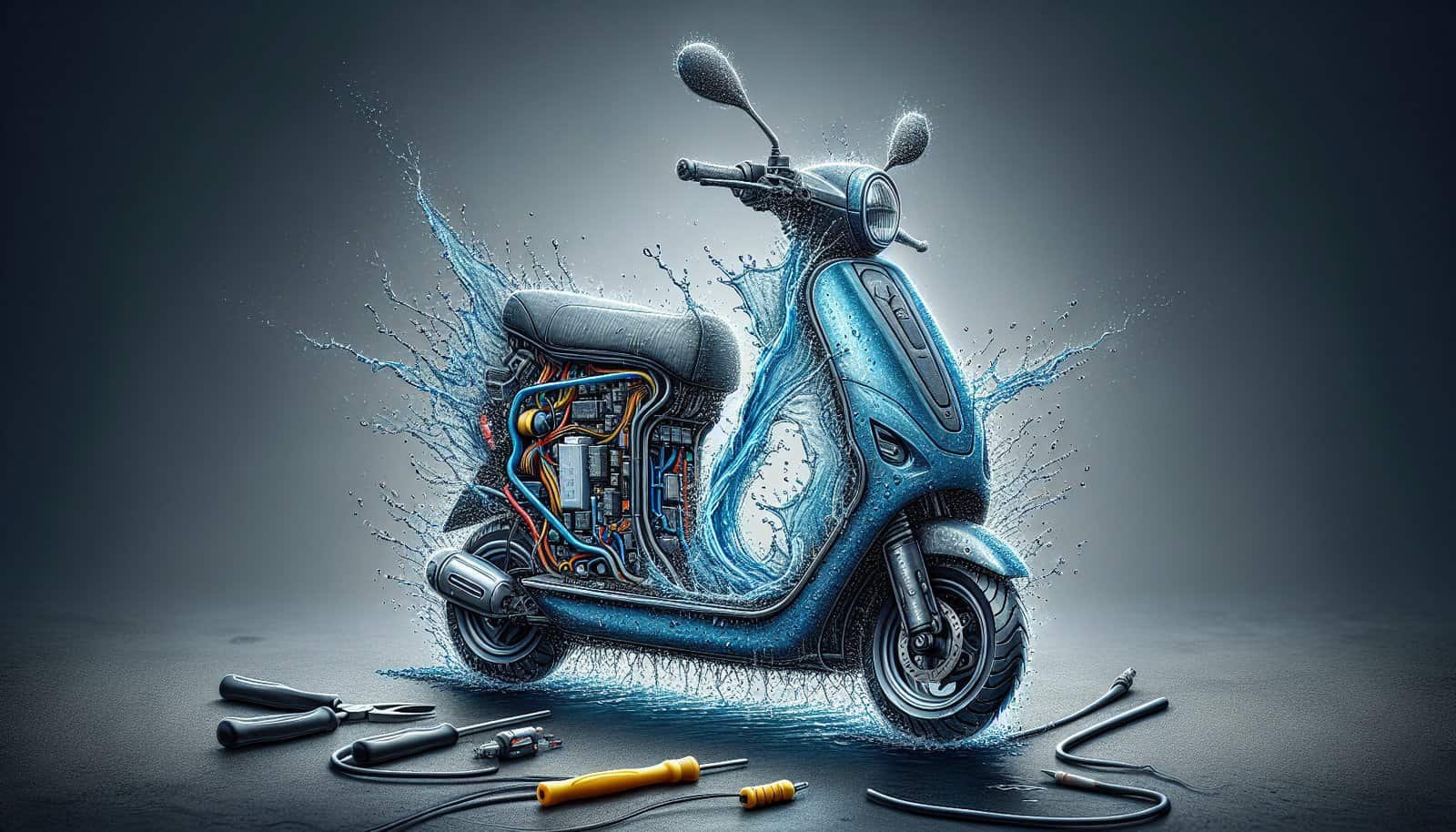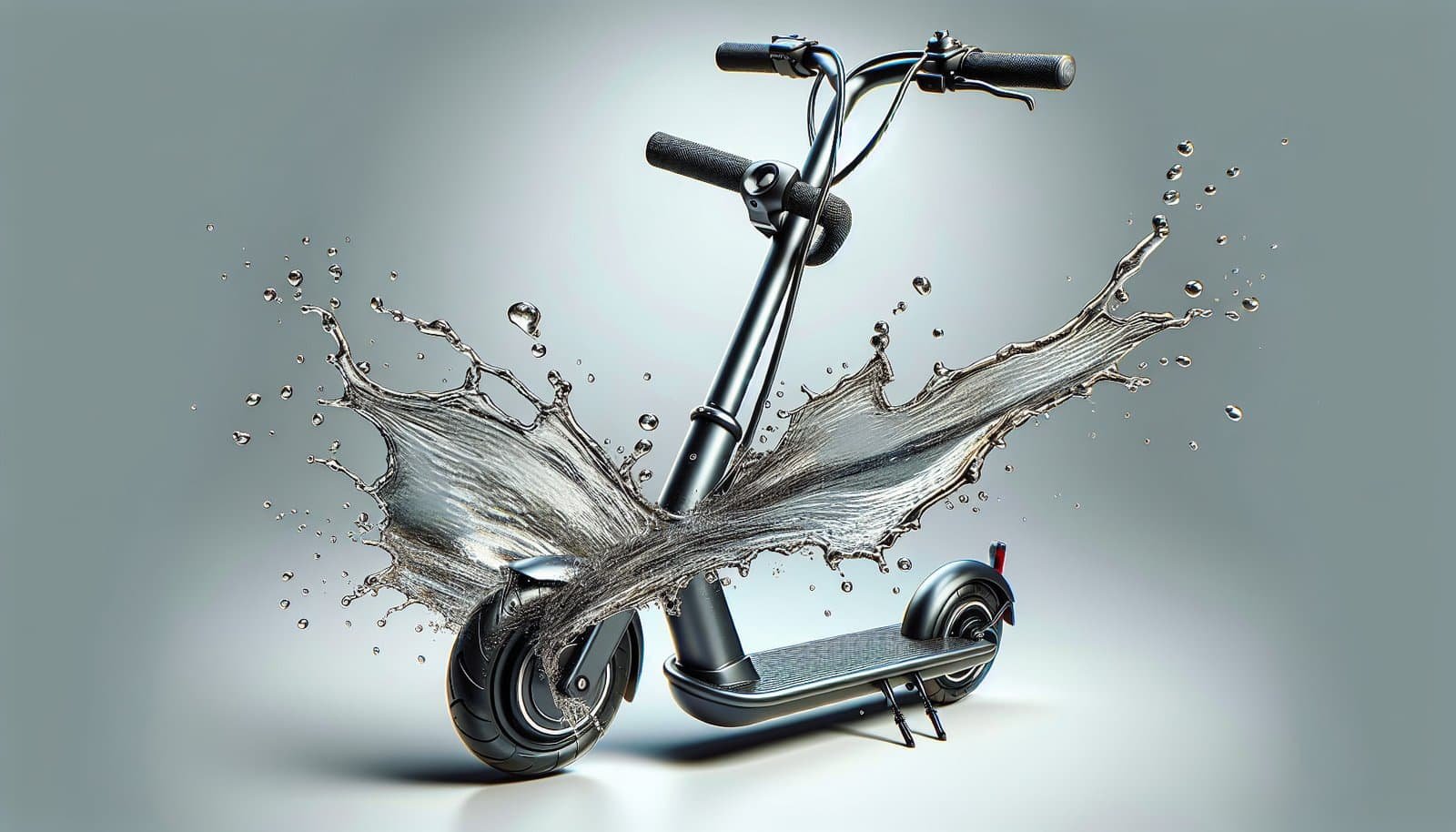So you’re out for a ride on your electric scooter and suddenly dark clouds roll in, followed by an unexpected downpour. Or perhaps you accidentally take a wrong turn and find yourself facing a large puddle, unable to avoid it. Now you’re wondering, “What should I do if my electric scooter gets wet or submerged in water?” Don’t worry, we’ve got you covered with some simple steps to help you handle this situation and ensure your scooter gets back on the road in no time.
Immediate Actions
Turn Off the Scooter
The first immediate action you should take is to turn off the scooter. This will help prevent any further damage to the electrical components and reduce the risk of short circuits. Simply locate the power switch and turn it off.
Remove Battery and Wipe Dry
Once the scooter is turned off, it’s crucial to remove the battery as soon as possible. Carefully detach the battery according to the manufacturer’s instructions and wipe it dry with a soft cloth. This will prevent any potential damage caused by water reaching the electrical connections.
Inspect for Visible Damage
After removing the battery, take a moment to inspect the scooter for any visible signs of damage. Check for cracks, breaks, or water accumulation in the body, frame, or other components. If you notice any physical damage, it’s important to address it to prevent further issues.
Dry the Scooter Thoroughly
To ensure the scooter is completely dry, use a soft cloth or towel to wipe away any moisture from the surface. Pay special attention to the nooks and crevices where water might have accumulated. It’s vital to remove all moisture to prevent corrosion and damage to the scooter’s electrical system.
Inspecting and Cleaning
Inspect Electrical Components
Once the scooter is dry, carefully inspect the electrical components for any signs of water damage. This includes the wires, connectors, and cables. Look for any discoloration, rust, or corrosion. If you notice any abnormalities, it’s best to seek professional assistance.
Check for Water in Cables and Connectors
Make sure to check the cables and connectors for any water accumulation. If water is present, use a soft cloth or paper towel to gently dry them. Avoid using excessive force or rubbing to prevent any damage to the internal wiring.
Clean with a Soft Cloth
To remove any dirt or grime that may have adhered to the scooter due to water exposure, use a soft cloth or sponge. Dampen it slightly with water or a mild detergent solution, and gently wipe the surface of the scooter. Avoid using abrasive substances or cleaning tools that may scratch or damage the scooter’s exterior.
Use Compressed Air for Drying
In hard-to-reach areas or components with intricate designs, using compressed air can be an effective way to remove any remaining moisture. Hold the canister at a safe distance and use short bursts of air to blow away any water droplets. Take caution not to direct the air at sensitive components to prevent further damage.

Battery Handling
Do Not Reconnect Immediately
After drying the battery and scooter, it’s important to resist the urge to reconnect them immediately. Give the scooter and battery ample time to dry completely before attempting to use them again. This will help ensure the safety and functionality of the scooter.
Inspect Battery for Damage
While the battery is separated from the scooter, conduct a thorough inspection for any signs of water damage. Look for waterlogged areas, corrosion on the terminals, or any unusual odor. If you notice any concerns, it’s best to consult a professional for further evaluation.
Dry and Clean Battery Terminals
Clean and dry the battery terminals using a soft cloth or brush. Ensure that all moisture is removed to prevent any potential short circuits or damage. Take care not to damage or bend the terminal connectors during the cleaning process.
Consider Professional Inspection
If you are unsure about the condition of your battery or lack the necessary expertise, it’s highly recommended to have it inspected by a professional. They have the knowledge and tools to assess the battery’s integrity and provide appropriate recommendations.
Drying and Air Circulation
Allow Scooter to Air Dry
Once thoroughly cleaned and inspected, it’s important to allow the scooter to air dry in a well-ventilated area. Avoid exposing it to direct sunlight or heat sources, as excessive heat may cause further damage. Patience is key during this drying process.
Use Fans or Dehumidifiers
To expedite the drying process, you can utilize fans or dehumidifiers in the area where the scooter is drying. Point the fans towards it or place a dehumidifier nearby to help remove moisture from the air. This can aid in reducing the drying time.
Avoid Excessive Heat
While it might be tempting to use a hairdryer or other heat sources to speed up the drying process, it’s crucial to avoid exposing the scooter to excessive heat. High temperatures can cause damage to delicate components and exacerbate any existing issues.
Monitor Drying Process
Throughout the drying process, it’s important to monitor the scooter closely. Keep an eye out for any signs of lingering moisture or unusual smells. If you notice any ongoing issues, it would be wise to seek professional assistance before attempting to use the scooter again.

Inspecting Brake System
Check Brake Performance
After the scooter has been dried and inspected, it’s essential to test the brake system. Ensure that the brakes are functioning properly and that there are no signs of reduced effectiveness or unusual sounds. Any abnormalities should be addressed promptly to maintain safety.
Remove Excess Water from Brake Components
Inspect the brake components, including the brake pads, rotors, and calipers, for any signs of water accumulation. Remove any excess water using a soft cloth or towel. It’s important to dry the brake system thoroughly to prevent any potential loss of braking power.
Apply Brake Cleaner and Lubricant
To further ensure the effectiveness of the brake system, consider using a brake cleaner and lubricant. Follow the manufacturer’s instructions and apply them to the relevant components. This will help remove any residual water, dirt, or debris, and keep the brakes in optimum condition.
Seek Professional Help if Needed
If you encounter any issues with the brakes or lack the necessary knowledge to address them, it’s crucial to seek professional help. Brake systems are critical for safety, and expert assistance can ensure they are functioning correctly.
Examining Motor and Controller
Check Motor for Water Damage
Carefully inspect the motor for any signs of water damage, such as rust, corrosion, or discoloration. Pay close attention to the motor’s internal components, including the wiring and electrical connections. If you detect any issues, it’s advisable to consult a technician for further evaluation.
Inspect Controller and Circuit Board
Similarly, inspect the controller and circuit board for any visible signs of water damage. Look for corrosion, discoloration, or loose connections. These components are crucial for the scooter’s operation, and any damage should be addressed promptly.
Dry and Clean Motor and Controller
If there is no visible damage to the motor, controller, or circuit board, proceed to dry them. Use a soft cloth or towel to wipe away any moisture, taking care not to apply excessive force that could damage delicate components. Ensure that they are completely dry before reconnecting them to the scooter.
Consult a Technician if Necessary
If you have any concerns about the motor, controller, or circuit board, it’s highly recommended to consult a technician. They have the expertise and specialized tools to diagnose and repair any water damage effectively.

Testing and Gradual Usage
Confirm Proper Functioning
Before riding your scooter in normal conditions, it’s essential to confirm that all components are functioning properly. Turn on the scooter and check the throttle response, brake performance, lights, and all other essential functions. Take note of any irregularities or malfunctions.
Test Ride in a Controlled Area
For initial testing, choose a controlled environment such as an empty parking lot or a quiet street. Gradually increase your speed to assess the scooter’s stability and performance. Pay close attention to any unusual sounds or movements.
Monitor Performance and Safety
During the test ride, monitor the scooter’s performance and safety features. Ensure that the brakes are responsive, the scooter maintains its balance, and the electrical components function as intended. If you observe any issues, it’s advisable to stop and address them before continuing.
Gradually Resume Normal Usage
If the test ride goes smoothly and without any concerns, you can gradually resume using your electric scooter in normal conditions. However, it’s important to remain vigilant and attentive to any changes in performance or unexpected behaviors. Regularly inspect and maintain your scooter to prevent future water-related issues.
Preventive Measures
Invest in Water-Resistant Scooters
To minimize the risk of water damage, consider investing in a water-resistant electric scooter. These scooters are designed to withstand light rain and wet conditions, offering improved protection against water ingress.
Cover Scooter During Rainy Weather
When not in use or during rainy weather, it’s advisable to cover your scooter with a waterproof cover. This simple preventive measure can significantly reduce the chance of water reaching vital components and causing damage.
Avoid Deep Puddles or Flooded Areas
To protect your scooter from water damage, avoid riding through deep puddles or flooded areas. Even if your scooter is water-resistant, it’s best to err on the side of caution and avoid unnecessary exposure to water.
Regularly Inspect and Maintain Scooter
Performing regular inspections and maintenance on your electric scooter can help identify potential issues before they become major problems. Check the scooter’s components, electrical connections, and overall condition periodically, following the manufacturer’s guidelines.

Seeking Professional Help
Assess Severity of Water Damage
If you are uncertain about the severity of water damage or lack the expertise to evaluate your scooter’s condition, it’s essential to seek professional help. They can thoroughly assess the damage and provide appropriate guidance.
Contact Manufacturer or Authorized Service Center
Reach out to the manufacturer or an authorized service center for your scooter brand. They have the knowledge and experience to handle water damage and can offer valuable advice on the next steps to take.
Follow Expert Advice and Instructions
When seeking professional help, carefully follow the expert’s advice and instructions. They may recommend specific actions or repairs based on your scooter’s condition. By adhering to their guidance, you can ensure the best possible outcome for your scooter.
Consider Warranty Coverage
If your electric scooter is still under warranty, check if water damage is covered. Warranty coverage may differ depending on the manufacturer and specific terms, so be sure to review the warranty documentation or contact the manufacturer directly.
Conclusion
Immediate Action is Essential
If your electric scooter gets wet or submerged in water, taking immediate action is crucial. Turning off the scooter, removing the battery, inspecting for damage, and drying the scooter are the first steps to minimize potential damage.
Thoroughly Inspect and Clean
Inspect and clean all electrical components, cables, connectors, and the brake system. Pay attention to any signs of water damage, corrosion, or unusual performance. Clean and dry the scooter, motor, controller, and battery terminals to prevent further issues.
Exercise Caution and Gradual Testing
Before resuming regular usage, confirm that all components are functioning properly. Test ride the scooter in a controlled area, monitor its performance, and ensure safety features are working as intended. Gradually resume normal usage to ensure everything is functioning correctly.
Learn from the Experience
Experiencing water damage with your electric scooter can be a learning opportunity. By investing in preventive measures, regularly maintaining your scooter, and following professional advice, you can minimize the risks of future water damage incidents.


